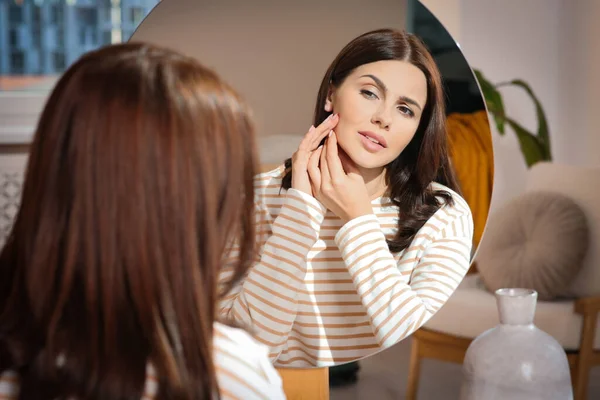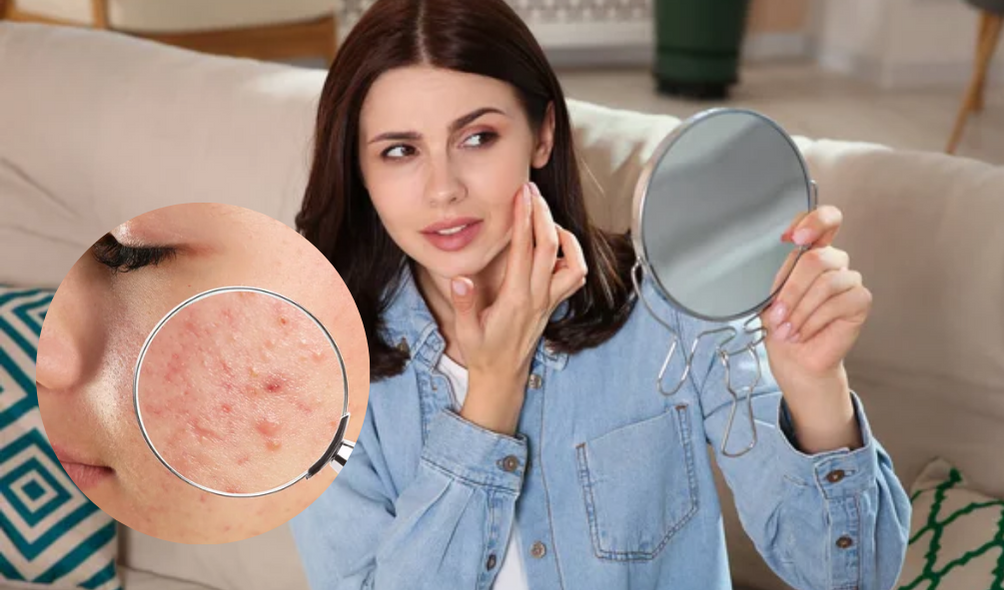Acne. Just the word can evoke a range of emotions, from frustration to self-consciousness. And while it’s often stereotyped as a teenage concern, acne can affect people of all ages, with jawline acne being a particularly common and persistent struggle for many.
As a public health researcher, I understand the significant impact acne can have on your well-being. It’s not just about the physical blemishes, but also the potential for emotional distress and a diminished sense of confidence. This article delves into the world of jawline acne, exploring its causes, effective treatments, and practical steps you can take to prevent future breakouts.

What is Jawline Acne?
Acne is a common skin condition characterized by clogged pores and inflammation, leading to pimples, whiteheads, blackheads, and cysts. While it can affect any area of the body, the face, chest, and back are most commonly affected.
Jawline acne specifically refers to breakouts that occur along the lower jawline, often concentrated around the chin and cheeks. It can be a persistent problem, affecting both teenagers and adults, with studies suggesting that up to 25% of adult women experience acne [1].
It’s important to distinguish jawline acne from other conditions that can cause bumps or blemishes on the jawline, such as folliculitis (inflammation of hair follicles) or perioral dermatitis (inflamed and reddened patches around the mouth). If you’re unsure about the cause of your breakouts, consulting a dermatologist for diagnosis is crucial.
Causes of Jawline Acne
Several factors can contribute to jawline breakouts, and understanding these triggers is crucial for effectively managing the condition. Let’s delve deeper into the key culprits:
- Hormonal Fluctuations:
Hormonal changes play a significant role in acne development, especially during puberty. A 2021 study published in the Journal of the American Academy of Dermatology found that androgen levels (hormones like testosterone) significantly impact sebum production, increasing the risk of clogged pores and breakouts. [2] These hormonal fluctuations can affect both men and women, though they may manifest differently.
- External Factors:
Beyond hormones, several external factors can exacerbate jawline acne:
- Friction and Pressure: Tight clothing, phone use against your cheek, and sporting equipment (helmets, chinstraps) can irritate the skin and trap bacteria, leading to breakouts. A 2020 study in the British Journal of Dermatology found that athletes were more likely to experience acne mechanica, a type of acne triggered by friction and pressure. [3]
- Comedogenic Products: Oil-based cosmetics, hair care products, and even sunscreens can clog pores and worsen acne. Look for products labeled “non-comedogenic” or “oil-free” to minimize this risk.
- Diet and Stress: While research on the direct link between diet and acne is ongoing, some studies suggest a potential connection. A 2018 review published in Dermatologic Clinics found that a high glycemic index diet (rich in processed carbohydrates and sugars) might contribute to acne development. Additionally, stress can worsen existing acne through the release of hormones like cortisol, which can increase sebum production. [4]
Understanding your personal triggers is crucial for managing your jawline acne. Reflect on your daily routine and identify any potential external factors that might be contributing to your breakouts.
Common Causes of Jawline Acne
| Cause | Explanation |
| Hormonal Fluctuations | Androgen increase leads to increased sebum production, clogging pores. |
| Friction and Pressure | Irritates the skin, creating an environment for breakouts. |
| Comedogenic Products | Oil-based products clog pores, trapping bacteria and triggering breakouts. |
| Diet and Stress | High-glycemic foods and chronic stress may worsen acne. |
How to Treat Jawline Acne
The good news is that there are effective options to combat jawline acne. Here, we’ll explore different treatment approaches:
- Over-the-counter (OTC) Products:
Several readily available OTC products can help manage mild to moderate jawline acne. These include:
- Benzoyl peroxide: This common ingredient helps kill bacteria and reduce inflammation.
- Salicylic acid: This beta-hydroxy acid (BHA) helps unclog pores and exfoliate dead skin cells.
- Alpha hydroxy acids (AHAs): These (e.g., glycolic acid, lactic acid) promote cell turnover and unclog pores.
Remember: Always patch test new products on a small area of your skin before applying them to your entire face.
- Prescription Medications:
For more severe or persistent acne, your dermatologist may recommend prescription medications, such as:
- Retinoids: These topical medications promote cell turnover and reduce sebum production.
- Antibiotics: Oral antibiotics can help combat bacterial overgrowth in the pores.
It’s crucial to speak to a dermatologist to develop a personalized treatment plan tailored to the severity and type of your acne.
A Guide to Preventing Jawline Acne: Your 6-Week Action Plan
Developing a consistent skincare routine and addressing potential triggers are essential for preventing jawline acne. Here’s a 6-week action plan to get you started:
Weeks 1 & 2: Establish a Gentle Skincare Routine
- Washing your face twice daily with lukewarm water and a non-comedogenic cleanser: This removes excess oil, dirt, and bacteria from your skin without stripping its natural moisture. [5]
- Moisturizing with a lightweight, oil-free moisturizer: This helps prevent your skin from overproducing oil to compensate for dryness, which can worsen breakouts. Look for moisturizers labeled “non-comedogenic” or “oil-free” to ensure they won’t clog your pores.
- Avoiding harsh scrubs and astringents: These can irritate the skin and worsen acne. Stick to gentle cleansing and opt for chemical exfoliation with AHAs 1-2 times a week if needed.
Week 3: Address External Triggers
- Identify and minimize friction and pressure: Consider wearing looser-fitting clothing, using headphones instead of holding the phone against your jaw, and adjusting hairstyles that might touch your jawline.
- Switch to non-comedogenic cosmetics and hair care products: Check labels for ingredients like “mineral oil,” “lanolin,” and “cocoa butter,” which can be comedogenic.
- Consider dietary changes: While research is ongoing, limiting processed foods and refined sugars may benefit some individuals. Consult a registered dietitian for personalized advice.
Weeks 4-6: Maintain Consistency and Monitor Progress
- Stick to your established routine: Consistency is key to seeing results. Give your chosen products time to work, and avoid switching products too frequently.
- Track your progress: Take pictures of your skin to monitor improvement. This can help you stay motivated and adjust your routine if needed.
- Seek professional guidance if needed: If your acne doesn’t improve after 6 weeks, or if it worsens, consult a dermatologist. They can provide stronger medications, address underlying hormonal issues, and personalize your treatment plan for optimal results.
Skincare Routine for Jawline Acne
Here’s a sample morning and evening routine for jawline acne:
Morning:
- Cleanse your face with lukewarm water and a gentle cleanser.
- Apply a lightweight, oil-free moisturizer with SPF 30 or higher.
Evening:
- Remove makeup with a gentle makeup remover.
- Cleanse your face with lukewarm water and a gentle cleanser.
- Apply a topical acne treatment as directed by your dermatologist or following instructions on OTC products.
- Apply a lightweight, oil-free moisturizer.
Remember:
- Exfoliate gently 1-2 times per week with a chemical exfoliant like AHAs to remove dead skin cells and promote cell turnover.
- Consult a dermatologist for personalized recommendations and product selection.
FAQ:
Q: Is jawline acne more common in men or women?
While acne can affect anyone, hormonal fluctuations often play a significant role in jawline acne, making it more common in women, particularly during their menstrual cycle, pregnancy, or menopause. However, men can also experience jawline acne due to hormonal fluctuations or other contributing factors.
Q: Can stress cause jawline acne?
Chronic stress can worsen existing acne by triggering the release of cortisol, which can increase sebum production. While stress may not directly cause acne, it can exacerbate breakouts in individuals already prone to it.
Q: What are some natural remedies for jawline acne?
While some natural remedies, like tea tree oil or aloe vera, are touted for their acne-fighting properties, research on their effectiveness is limited and often inconclusive. Additionally, these remedies can irritate the skin for some individuals. It’s crucial to consult a dermatologist before trying any home remedies to ensure their safety and effectiveness for your specific skin type and condition.
Q: When should I see a doctor about my jawline acne?
If your jawline acne is severe, painful, cystic, doesn’t improve with over-the-counter treatments within 6 weeks, or leaves scars, consult a dermatologist. They can diagnose the underlying cause, recommend appropriate treatment options, and help you achieve clear, healthy skin.
Conclusion
Jawline acne can be frustrating, but it’s a manageable condition. By understanding the causes, implementing a consistent skincare routine, addressing potential triggers, and seeking professional help if needed, you can achieve clearer, healthier skin and boost your confidence. Remember, consistency and patience are key to managing acne and maintaining long-term results.
Read Also: Flexitarian vs. Omnivore: Embracing Plant-Based Power for a Healthier Heart
Last Updated on February 29, 2024 by 247 News Around The World






